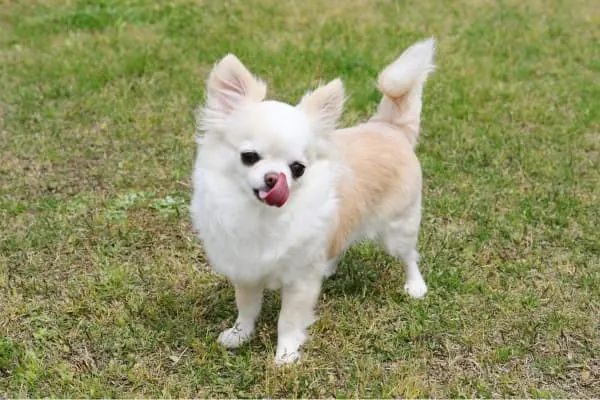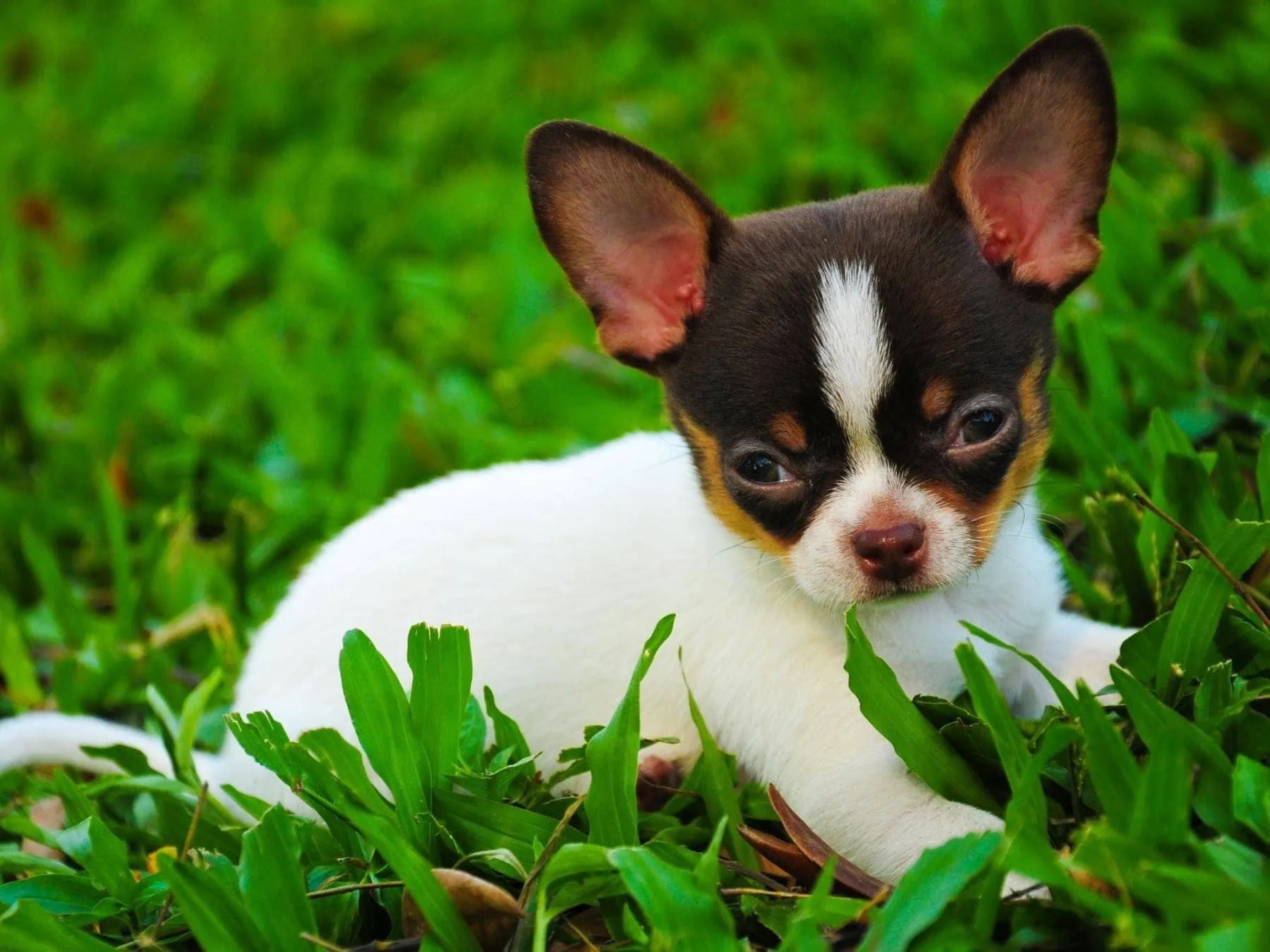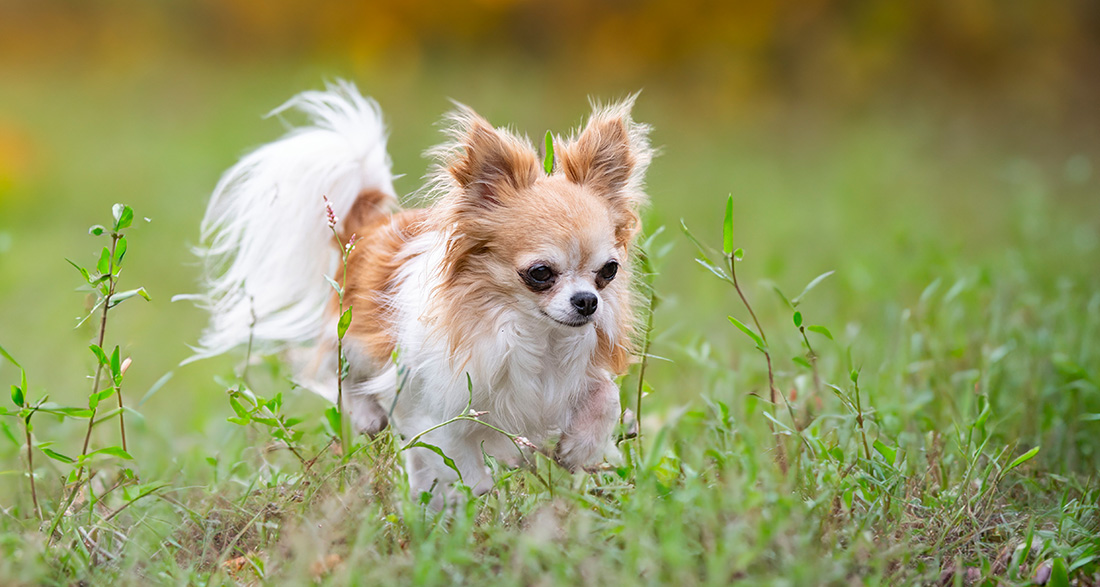The Chihuahua is not only the smallest dog breed in the world, but is also a worldwide favorite as a cute companion dog. Find out everything you ever wanted to know about this popular breed here!
Character, Traits, and Nature
The Chihuahua is a lively and affectionate dog:
- Chihuahuas are true one-person dogs. Once your Chihuahua has chosen to shower someone with its full affection, it forms a strong bond with that selected individual.
- Especially young Chihuahuas are charming attention-seekers.
- This small breed remains loyal to its chosen person, even if cared for by multiple individuals.
- When the little dog interacts with many people, it displays an amiable attitude toward them.
- If its loyalty matched its size, this unexpectedly robust companion dog, with its alert nature, would make an ideal protector.
Breed Overview
GROUP: Toy
HEIGHT: 5 to 8 inches
WEIGHT: Not exceeding 6 pounds
TEMPERAMENT: Loyal, alert, lively, attentive, bright, companionable
COAT: Smooth and short or longhaired
COAT COLOR: Black, black and tan, blue and tan, chocolate, chocolate and tan, cream, fawn, fawn and white, red
HYPOALLERGENIC: Yes
LIFE SPAN: 14 to 16 years
Pros and Cons

The Chihuahua is a companion dog without a working test and demands your undivided affection and warmth.
This comes with some advantages:
- Despite its size, the Chihuahua requires consistent training. But don’t worry: once you reach a certain training stage, it is exceptionally trainable and clever.
- Is a Chihuahua a family dog? Although the small dog mainly sticks to its chosen person, it can still serve as a family dog.
- How much exercise does a Chihuahua need? Surprisingly resilient and enduring, the companion dog is far from being a lapdog as it enjoys covering larger distances.
- Good news for athletic dog owners: While not a typical sports dog, the small breed can still enjoy activities like dummy work, obedience, dog dancing, or other sports.
Just as every dog is exceptional, various Chihuahua individuals possess unique personalities that occasionally come with disadvantages:
- If you pamper your Chihuahua too much, it may quickly become moody and may be less inclined to obey.
- If you want your Chihuahua to show the same level of affection to all your family members, you will unfortunately be disappointed. For the Chihuahua, there is only one fixed reference person.
- Due to its alert, courageous, and restless nature, the small dog fearlessly confronts even larger peers and animals. Because this can put your little rascal in precarious situations, you should always keep an eye on it.
Food for the Chihuahua

Do you know the nutritional needs of your Chihuahua? This depends on 9 nutritionally relevant factors, including its age, weight, size and activity, health condition, and allergies.
Since your Chihuahua, solely based on its size compared to most other dog breeds, has a lower requirement for minerals and vitamins, oversupply often appears, which can harm your dog’s health.
Origin and History
Documentary and archaeological evidence primarily point to Mexico, alongside China, Egypt, and Malta, rather than China, as the region of origin: Toltecs and Aztecs kept the breed as household dogs.
According to legend, Chihuahuas not only served as sacred sacrificial animals but were also revered by Aztec chiefs for their glowing eyes and round heads.
This went so far that the chiefs took the small dogs with them to their graves because they believed that the Chihuahuas would guide them through the underworld to paradise if they treated them well during their lifetime.
In the United States, Chihuahuas were discovered in the mid-19th century as charming, lively playmates, bred, and developed into their breed status. Soon, these small dogs spread from there to the whole world.
The attempt at a first breed description was made by Rosina V. Casselli in 1904 in the magazine “Our Dogs.” She was a variety artist who trained Chihuahuas for her performances.
After their first registration in the US breed book in the same year and the first standard of 1923, the appearance of the breed solidified.
Names
The Chihuahua owes its name to the province of the same name in Mexico, where it was kept over a thousand years ago. Although the origin of the companion dog is not entirely clear, small wild dogs, from which the breed seems to descend, still live in the Chihuahua area today.
Mix
As the Chihuahua is a very small breed, breeders predominantly cross them with other small breeds. Popular Chihuahua mixes include crosses with the Pug (Chug), the Papillon (Chion), the Miniature Pinscher (Chipin), or the Jack Russell Terrier (Jack Chi).
However, the specific canine character in such a Chihuahua mix, ultimately a hybrid breed, remains unknown until you have delved into this mixed breed.
Puppies

What does a Chihuahua look like?
The Fédération Cynologique Internationale (FCI) lists the Chihuahua in Group 9 “Companion and Toy Dogs” and in Section 6 “Chihuahueño, without a working test.” It describes it as a compact dog with an apple-shaped rounded head and a well-defined, broad stop.
Long Hair and Short Hair
There exist both a long-haired and a short-haired variety of Chihuahuas, each appearing in almost all color variations:
- In a short-haired Chihuahua, the fur from the neck to the tail can be slightly longer.
- Long-haired Chihuahuas have short hair on the head, front, and muzzle but exhibit a long and dense ruff and mane on their tail, ears, back of the legs, and chest.
- Bald areas on the body are not allowed according to the standard.
- The original Chihuahua type had short hair: A Botticelli fresco from 1482 depicts a white specimen with short hair, while long-haired Chihuahuas have only existed since the 20th century.
Color and Blue Merle
On September 15, 2010, the FCI (Fédération Cynologique Internationale) released a new breed standard for the Chihuahua.
Compared to the previous allowed breed characteristics, the new version includes some crucial changes:
- The genetically determined coat pattern Merle, often in the form of Blue Merle, is considered a disqualifying fault because it goes against a healthy breed standard.
- However, except for Merle variations, all colors in all shades and combinations are allowed.
- The open fontanelle is also no longer tolerated for health reasons.
- Other faults include, for example, drooping ears, small eyes, or a weight below 500 g or over 3 kg.
Mini-Chihuahua
Advertisements for so-called “Mini-Chihuahuas” often circulate on the internet. However, an even smaller type of the already smallest dog in the world is not provided for in the standard and should therefore be considered highly untrustworthy.
Diseases
The Chihuahua may experience the following typical nutrition-related dog diseases.
Dental and Tooth Diseases:
Due to the unique head shape of the Chihuahua, its dental arrangement and positioning differ significantly from other dog breeds. The result is dental misalignments that promote reduced abrasion during chewing and thus the formation of tartar:
✖ The most common dental misalignment in Chihuahuas is a too-narrow lower canine.
✖ Canines refer to the dog’s corner or fang teeth. These can unfavorably affect the upper jaw.
✖ If your Chihuahua has this misalignment, you should initiate orthodontic treatment early on.
Another breed-specific problem of the Chihuahua is milk tooth persistence:
✖ The milk teeth are still present, even though the permanent teeth have already come in during the tooth change.
✔ In this case, your veterinarian should extract your Chihuahua’s milk teeth because untreated milk tooth persistence can cause chronic inflammation in its jaw and oral mucosa.
✖ Remaining milk teeth can seriously damage the succeeding teeth.
✖ Dental misalignment with corresponding consequences can be expected.
Both dental misalignments and persistent milk teeth often lead, in conjunction with reduced chewing activity, to increased tartar formation. As a result, your Chihuahua may suffer from
✖ gum inflammation.
✖ damage to its tooth-supporting apparatus.
✖ in the worst case, tooth loss.
The most effective way to prevent tartar in your Chihuahua is daily tooth brushing:
✔ Introduce your Chihuahua to a toothbrush and toothpaste from an early age.
✔ Use soft dog toothbrushes and specially flavored dog toothpaste. Human toothpaste is not suitable for dogs.
✔ Our dental care set provides you with all the tools to promote your dog’s dental health.
You can reduce tartar formation in your Chihuahua through targeted feeding:
✔ The texture and consistency of special dry food kibble can induce stronger mechanical abrasion on your Chihuahua’s teeth and help clean its tooth surfaces.
✔ Increased fiber content ensures stronger mechanical abrasion.
✔ Additives such as polyphenols and zinc salts can inhibit the growth of bacteria involved in tartar formation.
✔ Essential oils have antibacterial effects, but use them sparingly due to compatibility. For example, studies prove strong antibacterial properties for eucalyptus oil, even surpassing the usual oral antiseptic chlorhexidine.
Urinary Stones
Due to a genetic defect, Chihuahuas are particularly prone to the formation of urate stones:
✖ This type of urinary stone forms primarily with an acidic pH of the urine.
✖ The consequences for your Chihuahua are symptoms resembling a bladder infection: bloody urine, frequent urination, and pain during urination.
You can prevent your Chihuahua from forming many stones by influencing the pH of its urine through diet composition:
✔ Ensure a moderate protein intake by preferring low-purine protein sources such as muscle meat, dairy, and egg products.
✔ Avoid feeding your Chihuahua other protein carriers like organ meats (liver, kidney) and certain fish species (sardines, anchovies) since they have a high purine content and thus promote urate stone formation.
✔ The addition of potassium citrate or sodium bicarbonate causes alkalinization, an increase in urine pH, and thus a reduction in urate stone formation.
✔ Gently encourage your Chihuahua to drink more to increase its urine volume and counteract stone formation.
Diabetes Mellitus
Compared to other dog breeds, Chihuahuas have an increased risk of developing diabetes:
✖ The disease is a metabolic disorder that either allows your Chihuahua to produce too little insulin (Type 1) or reduces the effectiveness of insulin (Type 2).
✖ Since insulin controls blood sugar levels, an elevated value is the result.
✖ Possible risk factors include overweight, a genetic predisposition, and previous inflammatory or metabolic diseases.
✖ Diabetes initially manifests in symptoms such as excessive thirst, frequent urination, fatigue, or weight loss, up to corneal clouding. A relatively symptom-free course is possible at the beginning of the disease.
✖ Untreated diabetes can lead to severe physical damage in the long run as blood vessels and kidneys are heavily burdened.
In addition to regular insulin injections, it is essential to support your Chihuahua’s therapy with dietary measures:
✔ Limit glucose flooding after feeding. To achieve this, avoid feeding your Chihuahua sugary foods with rapidly available carbohydrate sources (mono- and disaccharides).
✔ However, you can use more complex carbohydrates like starch since glucose release in these foods is very slow.
✔ Use rice, potatoes, pasta, corn, tapioca, millet, and grains. However, the food should not exceed a starch content of 50% in dry matter.
✔ Since fibers slow down the absorption of glucose from the intestine, you can use fiber content over 5% in an adjusted ration.
✔ Guar, wheat bran, and cellulose are suitable as fiber-rich feed.
✔ As an alternative or in addition to complex carbohydrates, use high-quality fats to ensure energy intake for your Chihuahua.
✔ The food should have a constant composition to avoid varying insulin requirements.
✔ Feed your diabetic Chihuahua as gently as possible with several small meals at set times.
Buying a Chihuahua
If you want to welcome this charming and sweet little dog into your home, the search for a reputable and trustworthy breeder begins.
Breeders
You will find healthy Chihuahua puppies from experienced breeders who are members of one of the clubs mentioned above. Dog breeds recognized by the FCI and bred by a VDH club must meet numerous requirements:
- Trained examiners from the breeding association and veterinarians check the nature and health of the parent animals.
- The breeding site must be in impeccable hygienic condition, and the mother dog must be healthy and open-minded.
- If a breeder tells you everything about their Chihuahuas, this is usually a clear sign of seriousness. In most cases, responsible breeders also want to know how their dogs are doing even after the puppies are given away.
Chihuahua in Need
Sometimes you may come across adult Chihuahuas in a breeding club or animal shelter:
Taking a Chihuahua in need into your home is not entirely unproblematic.
Since the small dog breed chooses a fixed reference person, you would likely have to do a lot of strenuous relationship work, especially in the first few months.
How Much Does a Chihuahua Cost?
The price for a Chihuahua from a reputable breeder with all papers is around €$200 to $1800.


